Doctors Note Template for School , also known as a medical certificate, is a formal written statement from a physician or other medical professional. It authenticates a student’s health condition as a valid reason for their absence. A doctor’s note is pivotal in communicating health concerns to the school administration, whether a short-term illness like the flu or a long-term condition requiring extended absence.
Understanding the Necessity of a Doctor’s Note
A doctor’s note is an integral document in the educational ecosystem, validating a student’s health-related absences and ensuring their well-being within the school setting. Below, we delve into its importance and functions in further detail, referencing authoritative sources.
Legal Requirements
According to the United States Department of Labor, employers (which can also apply to schools) can ask for a doctor’s note as proof of illness.
However, policies differ by country, state, and individual school policies. A legal document like a doctor’s note helps provide evidence for the absence and reduces potential legal disputes.
School Policy
School policies often necessitate a doctor’s note for absences exceeding a specific duration. This is to ensure that students are not missing school unnecessarily.
For instance, the New York City Department of Education has regulations requiring a note for an illness-related absence of more than three consecutive school days.
Child’s Health and Wellness
A doctor’s note is vital in this communication, detailing any specific care instructions or accommodations necessary for the student.
The American Academy of Pediatrics highlights the importance of effective communication between healthcare providers and schools to ensure a student’s health and well-being.
A doctor’s note goes beyond mere formality; it becomes a significant instrument for the child’s welfare, legal compliance, and adherence to school policies.
Its necessity is underscored by its role in facilitating the child’s right to education in tandem with their health and wellness. As such, it should be perceived as an essential document and managed with the due diligence it deserves.
For Notes:
- The New York City Department of Education: https://www.dol.gov/general/topic/workhours/sickleave
Elements of a Professional Doctor’s Note
A professional doctor’s note should contain specific elements to ensure its validity and usefulness. The following are key components of a doctor’s note:
The Header
It usually contains the word “Certificate” or “Medical Certificate.” It serves to identify the document’s purpose.
The Date
The Date when the certificate was issued. It helps the school track the student’s illness and absence timeline.
Medical Facility’s Information
includes the name, address, and contact information of the hospital or clinic. It adds a level of authenticity to the note.
Patient’s Information
It usually includes the student’s name and age. It ensures the note corresponds to the right student.
Medical Condition or Reason
The doctor mentions the medical condition or reason for the student’s absence. However, due to patient privacy rights, it may sometimes be vague or general.
Privacy is an essential aspect of medical ethics and law. Confidentiality, a key part of the doctor-patient relationship, is a right protected by various laws and regulations worldwide, such as the Health Insurance Portability and Accountability Act (HIPAA) in the United States.
While schools need the information to provide care and accommodation to their students, balancing this need with respect for a student’s privacy and dignity is important.
Here are a few alternative ways to communicate necessary information without compromising sensitive details:
- Use General Terms: Rather than disclosing a specific diagnosis, the note could state that the student is dealing with a “medical condition” or “health issue.” For example, instead of specifying a mental health disorder like depression, the note might say the student is dealing with “a mental health concern.”
- Focus on Accommodations: The note could emphasize the needed accommodations rather than the medical reason behind them. For example, it could say, “The student requires extra breaks during the day,” without specifying the underlying reason.
- Private Meetings: Sometimes, a private meeting between school authorities, the student, and their parents could be appropriate. It allows sharing of necessary information and accommodations to be arranged without putting sensitive information in writing.
- Professional Guidance: Consulting with healthcare and legal professionals can provide further guidance on maintaining privacy while ensuring the student’s needs are met.
Recommendations
A doctor’s note’s ‘Recommendations’ section provides vital guidance on how the school can best support students during their illness or recovery.
It outlines specific instructions from the doctor regarding the student’s care, school activities, and necessary accommodations. This portion of the note is particularly essential for facilitating an effective response from the school to the student’s health situation.
Here is a deeper look at the types of recommendations a doctor might provide:
- Care Guidelines: These may include instructions about medication, rest periods, dietary restrictions, or other care-related aspects that the school should be aware of. For instance, a student with diabetes might need regular breaks to monitor blood sugar levels and take insulin.
- Activity Restrictions or Modifications: The doctor’s note might specify any physical activity limitations, such as refraining from strenuous exercise for a student recovering from mononucleosis. For a student with a broken limb, the note might recommend avoiding certain types of play at recess.
- Accommodation Requirements: These are alterations to the student’s regular school routine or environment that enable them to continue their education despite health challenges. Accommodations could range from additional time for test-taking and providing a quieter study area to specialized educational assistance. For instance, a student with a concussion might require shorter school days or a modified screen-time policy.
- Timeline for Reassessment or Recovery: Recommendations include a projected timeline for recovery or a schedule for a reassessment of the student’s condition. It helps the school anticipate the adjustments’ duration and plan accordingly.
- Emergency Protocols: For certain health conditions, the doctor’s note might outline steps for the school to take in case of an emergency. For example, a student with a severe allergy might have specific instructions for using an EpiPen.
The recommendations provided in a doctor’s note are meant to bridge the gap between healthcare and education, ensuring that students can maintain their health and continue their academic progress. They facilitate clear communication between medical professionals, school administrators, teachers, and support staff, fostering a collaborative approach to the student’s well-being.
Doctor’s Signature
The doctor’s signature and often a stamp or seal of the medical facility. It provides final verification of the note’s authenticity.
The Dos and Don’ts of a Doctor’s Note for School
Like any other official document, certain protocols are associated with a doctor’s note for school.
- Dos:
- Ensure the note is legible, clear, and contains all necessary information.
- Submit the note to the school promptly.
- Keep a copy of the note for your records.
- Don’ts:
- Do not alter any information on the note.
- Only submit notes with clear and specific information.
- Be sure to submit the note early, as it can cause complications with the school’s attendance records.
Steps to Request a Doctor’s Note
Obtaining a doctor’s note for school involves a series of steps:
- Booking an Appointment: Schedule a medical appointment for the child. The doctor must personally assess the child’s health to issue a legitimate note.
- Discussing with the Doctor: Explain the situation to the doctor, mentioning the school’s requirement for a note if necessary.
- Receiving the Note: Once the doctor agrees, they will provide a written note during or after the appointment.
Doctors note template for school
Having seen the elements of a doctor’s note, a generic template might look something like this:
[Header: MEDICAL CERTIFICATE] [Date] [Medical Facility’s Information] [Patient’s Information] [Medical Condition or Reason] [Recommendations] [Doctor’s Signature and Stamp]
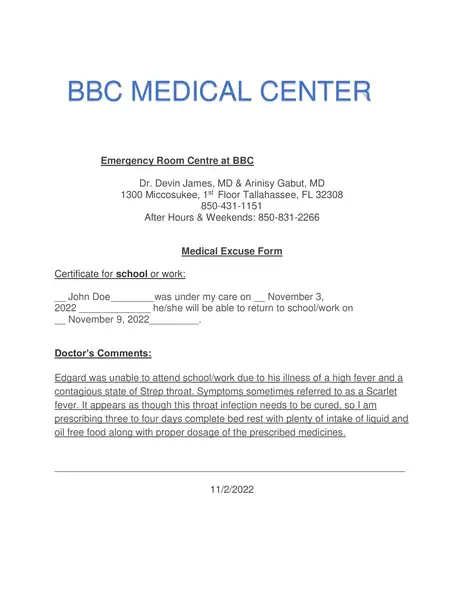
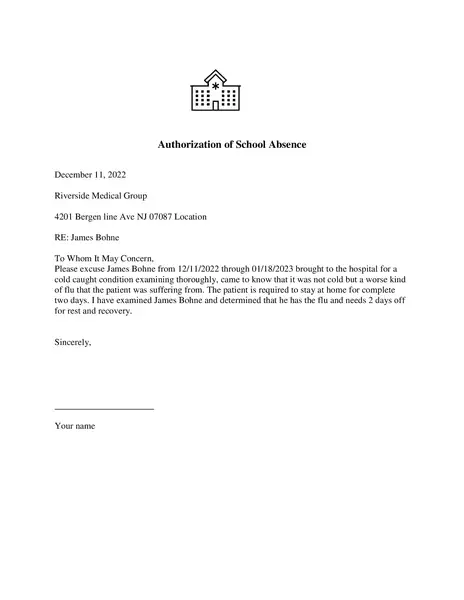
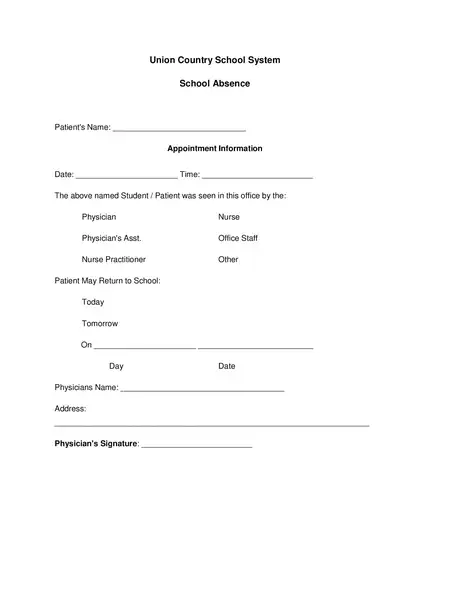
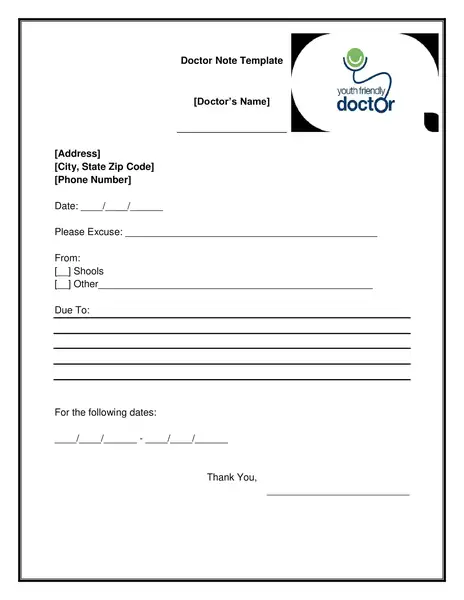
Variations of a Doctor’s Note for Different School Scenarios
Different health scenarios might require slightly different forms of a doctor’s note:
- Allergies: Allergies can range from mild irritants to severe, life-threatening situations. A student with an allergic condition should have a doctor’s note that specifies the allergen, potential reactions, and necessary precautions. It should also advise how the school can support the student during allergic reactions. For instance, a student allergic to bee stings might need a note like, “The student has a severe allergy to bee stings, which can cause anaphylactic reactions. An EpiPen must always be accessible and should be allowed immediate medical attention should a bee sting occur.”
- Contagious Diseases: For illnesses such as influenza, measles, or even COVID-19, a doctor’s note should not only validate the student’s condition but also indicate a safe return date. It helps prevent the spread of the disease within the school. For example, a note could read, “The student has been diagnosed with measles, which is highly contagious. They are expected to remain infectious for four days after the onset of the rash. Please excuse their absence during this period; they will safely return to school on [Date].”
- Mental Health Concerns: Mental health is crucial to a student’s well-being. A doctor’s note should provide necessary information while preserving the student’s privacy. For instance, a note could state, “The student is under my care for a mental health issue. Stress can exacerbate their condition. Please provide accommodations such as a flexible homework schedule or additional time for test-taking.”
- Physical Disabilities or Injuries: Students with physical disabilities or those recovering from injuries might need specific accommodations in school. For example, a student recovering from a leg injury might have a note like, “The student is currently recovering from a leg fracture and is using crutches. They should be exempted from physical education activities and given extra time to move between classes. They should also be allowed to use elevators if available.”
- Chronic Illnesses: For students with chronic conditions such as diabetes or epilepsy, a doctor’s note is crucial to communicate necessary regular or emergency treatments and possible triggers to avoid. A note could state, “The student has been diagnosed with Type 1 Diabetes. They will need to monitor their blood sugar levels regularly and may need to take insulin shots during school hours. Symptoms of low blood sugar can include dizziness, hunger, and confusion. If these symptoms occur, the student should be given a quick source of sugar and allowed to rest.”
The doctor’s note communicates essential information to the school to ensure a safe and supportive learning environment for the student. However, each case will be unique, and the doctor’s note should be personalized to the individual student’s needs. Parents and students are encouraged to communicate openly with the school and healthcare provider to manage these situations effectively.
Consequences of Misusing a Doctor’s Note
Misusing a doctor’s note, such as by providing falsified or misleading information, is a grave offense and can have substantial implications. It is a matter of academic integrity, legal repercussions, and societal honesty norms.
- Academic Consequences: In the academic world, integrity is paramount. If a student or a parent is found to have falsified a doctor’s note, schools can enforce various disciplinary actions. Depending on the severity and recurrence of the offense, these could range from warnings and probation periods to suspension or expulsion. The incident may also be recorded in the student’s academic records, affecting future opportunities.
- Legal Repercussions: Falsifying a doctor’s note can cross into legal issues, as it might involve forging a doctor’s signature or fraudulently impersonating a medical professional, which are criminal offenses in many jurisdictions. One could face fines, community service, or even imprisonment if caught and prosecuted.
- Damage to Reputation: The reputational damage associated with misusing a doctor’s note can be long-lasting. For the student, it could lead to a loss of trust in teachers, peers, and academic institutions. For parents, it might impact their standing within the school community.
- Compromised Medical Care: Falsifying a doctor’s note can also negatively impact the student’s medical care. If a false health condition is reported, it may lead to unnecessary interventions or conceal real health issues that require attention.
- Ethical Implications: On a broader level, misusing a doctor’s note raises serious ethical questions. It fosters a culture of dishonesty and undermines the values of trust and integrity that schools aim to cultivate in students.
A doctor’s note is not just an administrative issue but a severe act that can have far-reaching consequences on many levels. Students and parents must understand the implications of such actions and strive to maintain honesty in all health-related matters.
When a Doctor’s Note Might Not be Necessary
a doctor’s note is often the go-to document for verifying a health-related absence from school, there are scenarios where obtaining such a note might not be necessary. It is important to remember that the need for a doctor’s note varies based on individual school policies, the nature of the illness, and other situational factors.
- Minor Illnesses: For common, minor illnesses such as a cold or a stomach bug, a doctor’s visit – and, by extension, a doctor’s note – might not be necessary. These illnesses can usually be managed at home with rest and over-the-counter medications.
- Obvious Physical Injuries: In some cases, the nature of the illness or injury might be self-evident, such as a broken arm or a visible rash. A doctor’s note might not be necessary in these cases, as the school nurse or health personnel can easily verify the condition.
- Short-term Absences: Many schools might not require a doctor’s note if a student is absent for a day or two due to a non-serious condition. Parents or guardians can usually write a note explaining the student’s absence.
- Known Chronic Conditions: Students with known chronic health conditions, like asthma or diabetes, might have pre-established accommodation plans. A doctor’s note might not be necessary for these students each time a related incident causes school absences.
- Psychological Days: Some schools recognize the importance of mental health days, where students might need a day off to deal with stress or other mental health concerns. In such cases, a parent’s note might suffice.
- Current Health Crisis: During widespread health crises, like a pandemic, some schools might not require a doctor’s note to avoid overburdening healthcare systems.
These scenarios might not require a doctor’s note; it is always crucial to communicate openly with the school about a student’s health status and any resultant absences. Knowing the school’s policies can help parents and students navigate these situations appropriately.
How Schools Typically Handle Doctor’s Notes
Schools generally take doctor’s notes very seriously as they are official documents directly impacting a student’s health and academic record. Here is a typical process followed by schools:
- Receipt and Review: Once a doctor’s note is submitted, it is usually reviewed by a designated school official, often a school nurse or administrator. They confirm the note’s validity, looking at elements like the doctor’s signature and the medical facility’s information.
- Recording: The notes’ details, such as the duration of absence and reason, are recorded in the school’s attendance system. It helps schools track students’ attendance and identify potential issues, such as frequent absences due to health concerns.
- Communication: The relevant details from the note are then communicated to the necessary parties. It typically includes the student’s teachers and, in some cases, the school counselor or other staff who might need to provide additional support.
- Implementation of Accommodations: Based on the recommendations in the note, the school makes necessary accommodations. It could include excusing absences, adjusting the student’s schedule, or implementing a care plan for students with chronic illnesses.
Schools’ Specific Requirements for Doctor’s Notes
While these can vary depending on the school and local regulations, some common requirements include:
- Timing: Schools often require doctor’s notes to be submitted promptly after a student’s absence. Submissions must be on time to be accepted or could result in unexcused absences.
- Content: The note must contain details like the student’s name, medical condition or reason for absence, recommended accommodations, and the doctor’s signature.
- Legibility and Clarity: The note should be legible and clear. Schools may only accept notes that are easy to read or understand.
Tips for Effective Communication between Parents, Students, and School Administrators
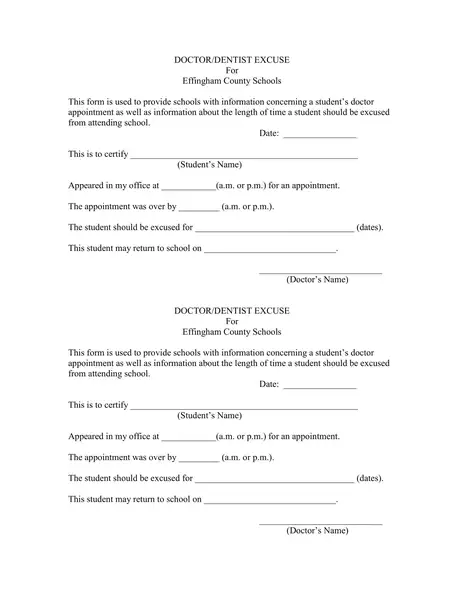
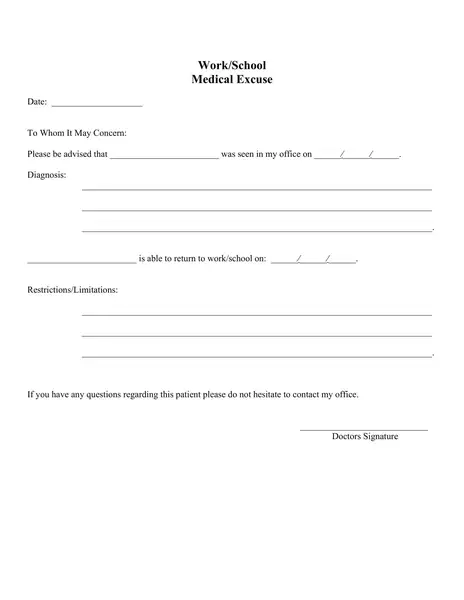
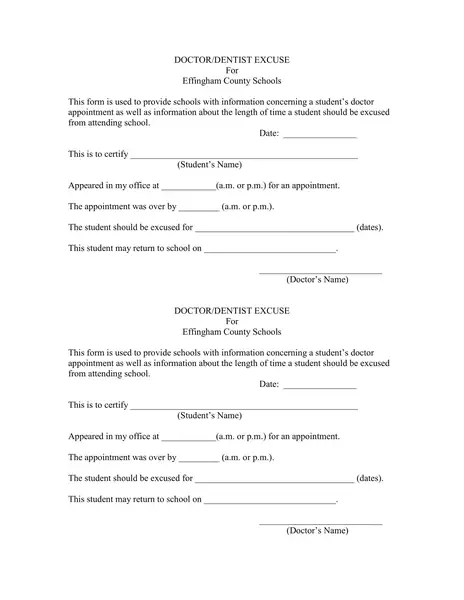
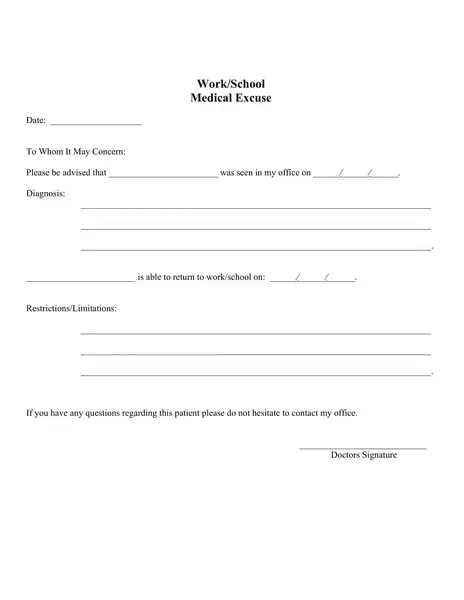
Effective communication is essential for managing health-related absences and accommodations. Here are some tips:
- Proactive Communication: Parents should inform the school as soon as they know their child will be absent due to health issues. If the condition is chronic or requires long-term accommodation, this should be discussed at the beginning of the school year.
- Discuss and Understand School Policies: Parents and students should understand the school’s absences and medical accommodations policies. If anything is unclear, it is important to ask for clarification.
- Maintain Open Dialogue: Regular check-ins between parents, students, and school administrators can help address any ongoing or arising issues. It is especially important for students with chronic health conditions.
- Involve the Student: As appropriate for their age and maturity, students should be involved in discussions and decisions about their health management in school. It can help them advocate for their own needs.
By understanding how schools handle doctor’s notes, their specific requirements, and how to communicate effectively, parents and students can help ensure health-related absences and accommodations are managed smoothly.
Conclusion
A doctors note for school, or a medical certificate, plays a crucial role in maintaining the well-being of students and the efficient operation of schools. It is a formal justification for a student’s health-related absence, communicating vital information to the school administration. It is not merely an administrative formality but carries legal and policy requirements, ensuring that a student’s health and wellness are properly considered and managed.
A professional doctor’s note usually includes specific elements like the Date, medical facility’s information, patient’s information, medical condition, recommendations, and the doctor’s signature. Adherence to certain protocols like the legibility of the note, timely submission, and non-alteration of information is critical.
Misusing a doctor’s note can lead to serious academic and legal consequences, damage one’s reputation, compromise medical care, and breach ethical standards. Thus, maintaining honesty in health-related matters is paramount.
A doctor’s note is often necessary; there are situations where it may not be required, such as minor illnesses, obvious physical injuries, short-term absences, known chronic conditions, psychological days, and during a health crisis. However, open communication with the school about the student’s health status is vital in all scenarios.
A doctor’s note is a critical tool that bridges communication between healthcare providers and schools, ensuring students’ overall health and well-being.

The content creator team at calipsotree.com is dedicated to making topics accessible to everyone, with over 9 years of experience in writing and breaking down complex concepts into easy-to-understand articles that answer readers’ financial questions.








